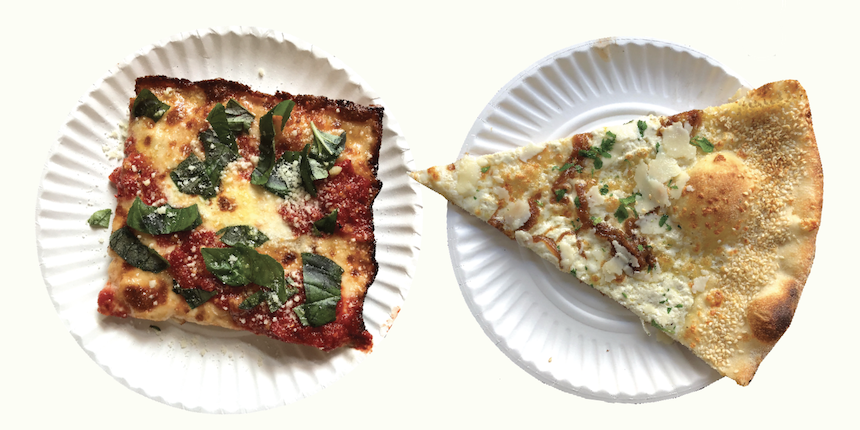The Dough Doctor on Making Chicago Thin Crust and Chicago Thick Pizza
Chicago is perhaps best known for its deep-dish pizza, that ooey, gooey, cheesy, saucy concoction served in round pans (read on for more on creating this type of crust). But a rise in what is known as Chicago thin-crust is gaining popularity. This cracker-like pizza is less about the toppings and more about the dough.
Chicago Thin Crust Pizza Dough
Typically, Ceresota flour is used in making this type of crust. If that isn’t available to you, any good, patent grade bread flour with 10.5- to 11.5-percent protein content should work well. If all else fails, an H&R (hotel and restaurant) flour should work for making this type of crust, too.
A planetary type mixer will work best for mixing this dough. You will need to use a dough sheeter/roller to form the dough into skins. You could roll the dough by hand, but you will soon find this to be a lot of work. Hot and cold presses are just not suited to this production method.
And remember, when mixing the dough, if in doubt, err on the side of under mixing the dough. The worst thing that you can do is to over mix this dough.
Chicago Thin Pizza Dough Recipe and Dough Formula
Formulation
Flour 100 percent
Salt 1.50
Sugar (optional) 1.50
Compressed yeast 0.25
Corn oil 8.00
Unsalted butter (optional) 4.00
Water (variable) (70 F) 45.00
Note: Some Chicago style crust doughs are made using a 50/50 blend of olive and corn oil.
Here’s the procedure for making the thin crust:
- Add the water to the mixing bowl, than add the salt and sugar to the water.
- Add the flour, followed by the compressed yeast and butter if used.
- Begin mixing at low speed and gradually pour in the oil over about 60 seconds.
- Continue mixing for a total of about 4 to 5 minutes at low speed, or until about ¼ of the flour is still seen as white, dry flour in the mixer.
- Transfer the dough mix to a plastic tub and cover to prevent drying.
- Allow the dough to ferment/rise in the tub for 4 to 5 hours.
- Bring the dough to the bench and scale into desired weight pieces and then form into balls.
- Place the dough balls into dough boxes, wipe lightly with oil, and cross stack in the cooler for two hours. Down stack the dough boxes and nest to prevent drying.
- Remove dough balls from the cooler 2 hours before anticipated use, and allow to warm at room temperature.
- Flatten the dough ball(s) by hand and feed into the sheeter/roller to give a finished skin of desired thickness.
- Trim the dough to the desired diameter using a knife or pizza cutter.
- Apply slices of mozzarella cheese to the dough skin, followed by the sauce and toppings.
- Pizzas can be baked on the deck/stone or on a screen/disk if desired.
Making Chicago Thick Pizza
For making a Chicago style thick crust, the following formula modifications are suggested:
- Include the optional unsalted butter in the formula for improved flavor.
- Increase the dough water to 50 percent of the weight of the flour.
- Add egg shade coloring if desired.
Procedures for Making Chicago Thick Pizza
Here are the procedural changes:
- Increase the weight of the dough balls to be appropriate for the diameter of pizza crusts being made.
- Adjust the sheeter roll settings to give a sheeted dough piece approximately ¼-inch thick.
- Cut the dough piece to the desired diameter using a knife or pizza cutter.
- Place the cut/trimmed dough skin into a dark colored (anodized finish) deep-dish (2-inch deep) pan that has been oiled with salad oil or an olive oil/salad oil blend.
- Allow the panned dough to rise for about 45 to 60 minutes.
- Using your fingers, carefully pull some of the dough up the sides of the pan to form a raised edge.
- Apply sliced mozzarella cheese to the dough surface of the dough, add the sauce followed by toppings.
- Bake at 425 to 450 F in a deck oven, or at 400 to 415 F in an impingement oven. These pizzas should be given a long, slow bake to develop their unique flavor and texture. When baking in a deck oven a wire screen placed under the deep-dish pan will help to keep the bottom of the pizza from getting too dark or burning during the lengthy baking time.
- Cut the finished pizza using a rocker knife.
Note: Part of the Chicago-style deep-dish pizza eating experience is in the flavor of the finished pizza. This flavor results from the use of raw sausage in the assembly of this type of pizza. Be sure to take appropriate food safety measures when handling/using raw sausage. u
Tom Lehmann is a director at the American Institute of Baking in Manhattan, Kansas.
>> Explore Pizza Dough Recipes for Top Trending Pizza Styles including Detroit, New York, Grandma, Sicilian, Chicago Thin and Deep Dish. <<







